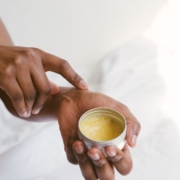Discussion on Palladium granuloma
Title:Palladium-induced allergic contact granuloma in a child wearing an earring
Original article:
Gonzalez-Perez, R, Carrillo-Ruiz, G, & Soloeta, R. Sarcoid-type Allergic Contact Granuloma Caused by Earrings in a Boy. Actas Dermo-Sifiliográficas (English Edition). 2012;103(1):73-74. doi: 10.1016/j.adengl.2010.12.008
Reviewed by Jack Guccione, BS. MSIII & Brittanya Limone, MA, BS, MSIV. Loma Linda University School of Medicine
Case Description
- A case of granulomatous allergic contact dermatitis (ACD) in an 11-year-old boy due to an earring containing palladium reported in Spain.
- He complained of a firm, asymptomatic papule on his left earlobe that had been present since he began wearing an earring 3-years prior.
- Surgical removal and pathology evaluation of the papule revealed a reactive “sarcoidal granulomatous infiltration with no evidence of refringent material”, suggesting that the papule did not form due to retention of a foreign body (metal fragment) present in the skin.
- Skin patch testing determined that the boy was sensitized to palladium.
- Palladium chloride skin patch testing resulted in a primary eczematous response.
- Mass spectrometry of the patient’s earring identified palladium as the primary metal composing the earring.
- Given the temporal association between the skin patch testing and confirmation of palladium in the earring, the diagnosis of granulomatous allergic contact dermatitis reaction (gACDr) due to palladium was made [aka palladium granuloma].
- The boy stopped wearing his earring and there was complete resolution of the reaction, confirming the diagnosis of palladium granuloma.
Discussion:
- Sarcoidal-type (non-caseating/non-necrotizing) granulomas are abnormal nodules composed of inflammatory immune cells and macrophages.
- They develop in response to a perceived need of the skin to encase a ‘foreign’ substance it is unable to eliminate.
- This type of granuloma suggests the lesion is not caused by an infection from Mycobacteria tuberculosis, Treponema pallidum (syphilis) or some fungi, all of which can cause the necrotizing (internally breaking down) type of granuloma.
- Several metals have been reportedly to cause gACDr (See Table 1).
Allergic contact granulomas are a less common presentation (variant) of allergic contact dermatitis. The article was reviewed to acknowledge the spectrum of allergic dermatitis.
Table 1. Metals and Respective Sources Implicated in Granulomatous ACD
| Metal |
Sources of Exposure |
| Palladium |
Earrings |
| Beryllium |
Mining
Fluorescent lighting tubes
Beryllium alloy production |
| Aluminum |
Vaccine & hypo-sensitization extract adjuvants
Deodorants
Tattoos |
| Zirconium |
Deodorants |
| Titanium |
Pacemakers |
| Mercury |
Tattoos |
| Chromium |
| Cobalt |
References:
Gonzalez-Perez, R, Carrillo-Ruiz, G, & Soloeta, R. Sarcoid-type Allergic Contact Granuloma Caused by Earrings in a Boy. Actas Dermo-Sifiliográficas (English Edition). 2012;103(1):73-74. doi: 10.1016/j.adengl.2010.12.008
Lubeck, G., & Epstein, E. (1952). COMPLICATIONS OF TATTOOING. California Medicine, 76(2), 83–85.

 Photo by Retha Ferguson from Pexels
Photo by Retha Ferguson from Pexels



